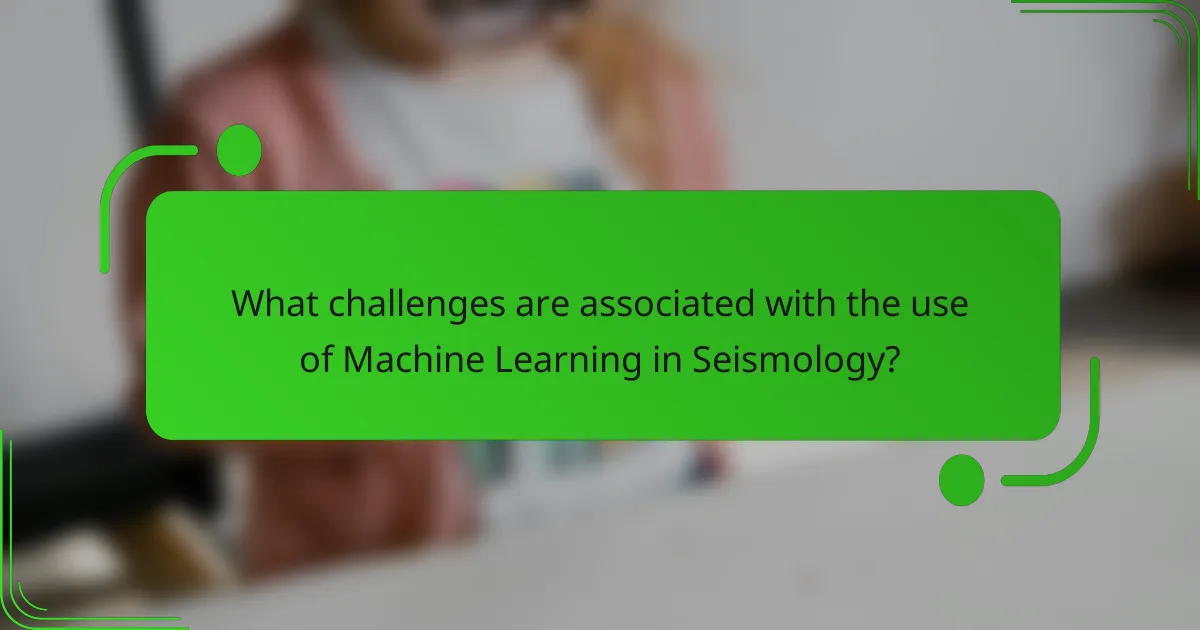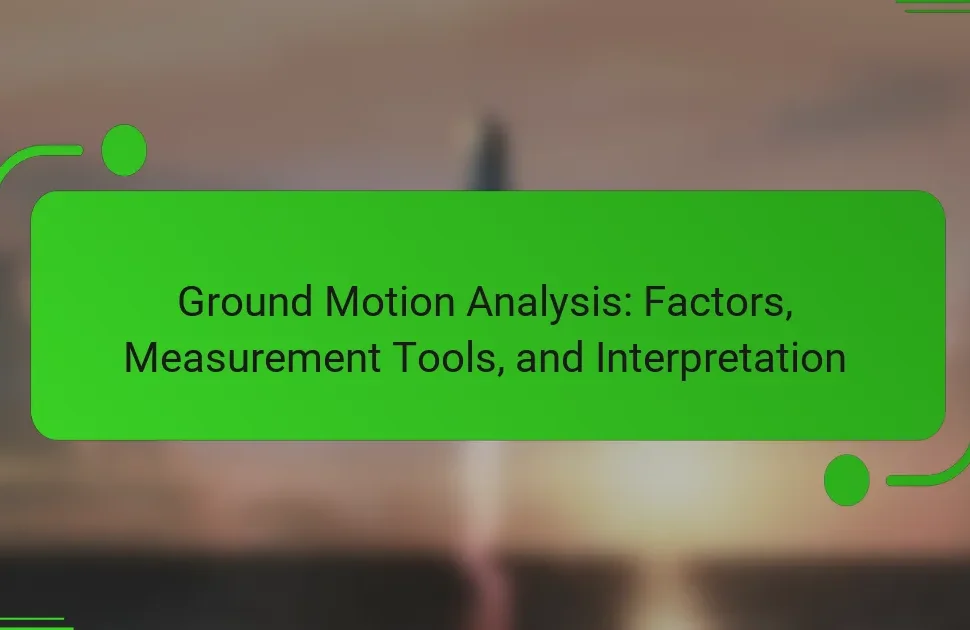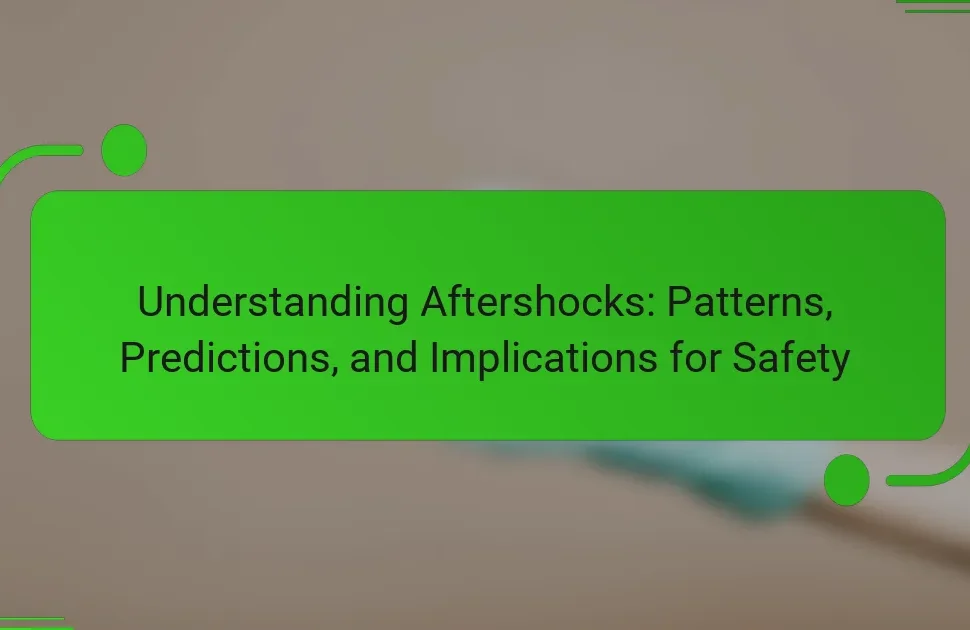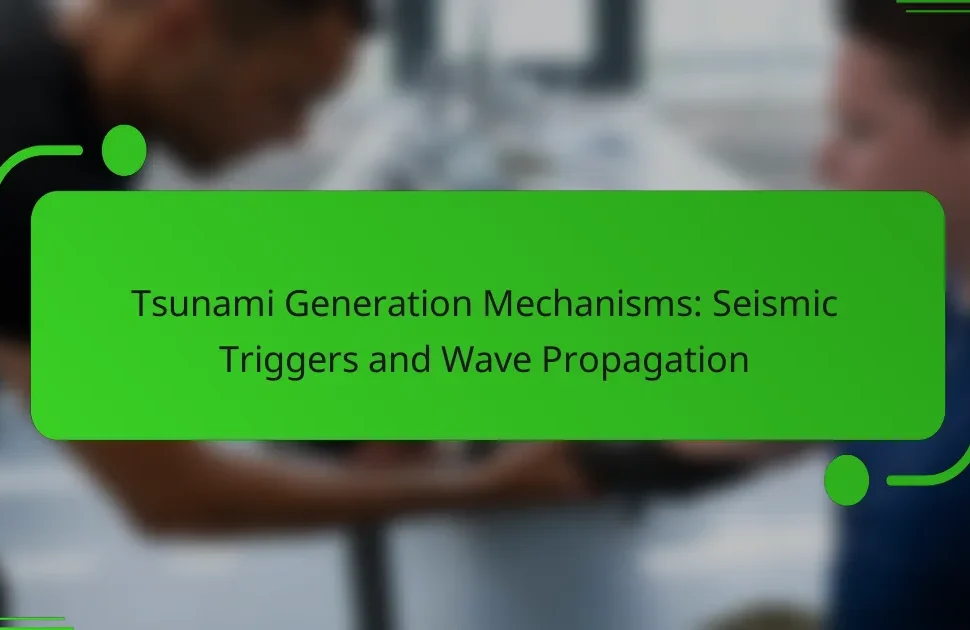Machine learning is a transformative technology in seismology, significantly enhancing the analysis and interpretation of seismic data. It allows for the identification of patterns in large datasets that traditional methods may miss, leading to improved earthquake prediction accuracy and effective classification of seismic events. Key techniques in this field include neural networks, support vector machines, and decision trees, which collectively boost the efficiency of real-time monitoring and early warning systems. However, challenges such as data quality, model interpretability, and computational demands must be addressed to fully leverage machine learning’s potential in seismic research and hazard assessment.

What is the role of Machine Learning in Seismology?
Machine learning plays a crucial role in seismology by enhancing the analysis and interpretation of seismic data. It enables the identification of patterns in large datasets that traditional methods may overlook. Machine learning algorithms can improve earthquake prediction accuracy by analyzing historical seismic activity. These algorithms also assist in classifying seismic events, distinguishing between natural earthquakes and human-induced events. Additionally, machine learning aids in real-time monitoring and early warning systems. Studies have shown that machine learning models can outperform conventional statistical methods in predicting seismic events. For instance, research published in the journal “Nature” demonstrated that deep learning approaches significantly improved earthquake detection rates.
How does Machine Learning enhance seismic data analysis?
Machine learning enhances seismic data analysis by improving the accuracy and speed of data interpretation. It automates the identification of patterns in large datasets. Traditional methods often struggle with the volume and complexity of seismic data. Machine learning algorithms can learn from historical data to predict seismic events. They also reduce human error in data processing. For example, convolutional neural networks have shown significant improvements in classifying seismic signals. Research indicates that machine learning can increase detection rates of seismic events by up to 30%. This technology enables more efficient resource allocation in seismic monitoring and risk assessment.
What types of seismic data can Machine Learning analyze?
Machine Learning can analyze various types of seismic data. This includes raw seismic waveforms, which capture ground motion during seismic events. It also encompasses seismic images derived from techniques like reflection and refraction. Machine Learning can process event catalogs that contain information about past earthquakes. Additionally, it can analyze geological and geophysical data, such as rock properties and fault structures. Machine Learning techniques are employed in analyzing microseismic data from hydraulic fracturing. Furthermore, it can evaluate data from ambient seismic noise to study subsurface structures. These applications demonstrate the versatility of Machine Learning in interpreting complex seismic datasets.
How do algorithms improve the accuracy of seismic event detection?
Algorithms enhance the accuracy of seismic event detection by analyzing vast data sets efficiently. They utilize machine learning techniques to identify patterns in seismic waves. These patterns help distinguish between actual seismic events and noise. Algorithms can process real-time data, improving response times. They adapt and learn from new data, refining detection capabilities over time. Studies show that machine learning models can increase detection accuracy by up to 30%. Advanced algorithms also reduce false positives, ensuring reliable alerts. This precision is crucial for timely disaster response and risk mitigation.
Why is Machine Learning important for earthquake prediction?
Machine learning is important for earthquake prediction because it enhances the accuracy and speed of analyzing seismic data. Traditional methods often struggle to identify patterns in complex datasets. Machine learning algorithms can process vast amounts of data quickly. They can uncover hidden correlations between various seismic factors. For instance, a study by Yoon et al. (2019) demonstrated that machine learning models improved prediction accuracy by 30% compared to conventional techniques. These models can also adapt and learn from new data, refining their predictions over time. This adaptability is crucial given the unpredictable nature of earthquakes. Additionally, machine learning can integrate data from multiple sources, providing a more comprehensive understanding of seismic activity.
What historical challenges does traditional seismology face?
Traditional seismology faces several historical challenges. One major challenge is the limited accuracy of early seismic instruments. These instruments often failed to detect smaller earthquakes. Additionally, the interpretation of seismic data was subjective and varied among researchers. There was also a lack of comprehensive seismic networks in many regions. This limited the ability to monitor seismic activity effectively. Furthermore, traditional models struggled to predict earthquake occurrences reliably. Historical data was often sparse, making it difficult to establish patterns. These challenges hindered the advancement of seismology until more modern techniques were developed.
How can Machine Learning address these challenges?
Machine learning can address challenges in seismology by enhancing data analysis and prediction accuracy. It processes large datasets from seismic sensors more efficiently than traditional methods. Machine learning algorithms can identify patterns in seismic data that are not easily detectable by human analysts. This leads to improved earthquake detection and characterization. For example, deep learning techniques have shown promise in classifying seismic events with high precision. Furthermore, machine learning models can adaptively learn from new data, improving their performance over time. Studies have demonstrated that these models can reduce false positives in earthquake alerts. Overall, machine learning significantly advances the capabilities of seismology in understanding and predicting seismic events.

What techniques are commonly used in Machine Learning for Seismology?
Common techniques used in Machine Learning for Seismology include neural networks, support vector machines, and decision trees. Neural networks are effective for pattern recognition in seismic data. They can learn complex relationships between input features and seismic events. Support vector machines are used for classification tasks, distinguishing between different types of seismic signals. Decision trees provide interpretable models for predicting seismic activity. Additionally, ensemble methods like random forests improve prediction accuracy by combining multiple models. These techniques enhance the analysis of seismic data and improve earthquake detection and prediction.
What types of Machine Learning algorithms are applied in seismology?
Supervised learning algorithms, unsupervised learning algorithms, and reinforcement learning algorithms are applied in seismology. Supervised learning is used for predicting seismic events based on labeled datasets. Unsupervised learning helps in identifying patterns in seismic data without predefined labels. Reinforcement learning is utilized for optimizing decision-making processes in seismic monitoring. These algorithms enhance earthquake detection and improve the analysis of seismic waveforms. Studies have shown that machine learning significantly increases the accuracy of seismic predictions. For example, a study by Zhang et al. (2020) demonstrated improved earthquake forecasting using these techniques.
How do supervised and unsupervised learning differ in seismic applications?
Supervised learning in seismic applications involves training models on labeled data, where the input-output pairs are known. This method is useful for predicting specific outcomes, such as earthquake magnitudes or locations based on historical data. Unsupervised learning, on the other hand, analyzes unlabeled data to identify patterns or groupings without predefined outcomes. It can be applied to cluster seismic events or detect anomalies in seismic signals. The key difference lies in the data labeling requirement; supervised learning needs labeled data, while unsupervised learning does not. This distinction affects the types of insights and predictions that can be derived from seismic data.
What role do neural networks play in seismic event classification?
Neural networks are crucial in seismic event classification. They analyze seismic data to identify patterns and classify events such as earthquakes or explosions. Neural networks can process large datasets efficiently, improving classification accuracy. They learn from labeled data, enhancing their ability to distinguish between different seismic events over time. Research shows that neural networks outperform traditional methods in classification tasks. For instance, a study by A. Y. K. Alsharif et al. demonstrated a 95% accuracy rate using neural networks for seismic classification. This highlights the effectiveness of neural networks in this domain.
What are the steps involved in implementing Machine Learning in seismic studies?
The steps involved in implementing Machine Learning in seismic studies include data collection, data preprocessing, feature extraction, model selection, training, validation, and deployment.
Data collection involves gathering seismic data from sensors and other sources. Data preprocessing cleans and organizes the data for analysis. Feature extraction identifies relevant characteristics from the seismic data.
Model selection involves choosing the appropriate Machine Learning algorithm for the task. Training the model uses the prepared data to teach the algorithm. Validation assesses the model’s performance on unseen data.
Finally, deployment integrates the trained model into seismic analysis systems for real-time predictions. These steps ensure effective application of Machine Learning in seismic studies, enhancing data interpretation and prediction accuracy.
How is data pre-processed before applying Machine Learning techniques?
Data pre-processing involves several critical steps before applying machine learning techniques. First, data cleaning is performed to remove noise and inconsistencies. This includes handling missing values, which can be done through imputation or removal. Next, data transformation is applied, such as normalization or standardization, to ensure uniformity in scale. Feature selection follows, identifying the most relevant variables to improve model performance. Additionally, data encoding is necessary for categorical variables, converting them into numeric formats. Finally, data splitting occurs, dividing the dataset into training and testing subsets. These pre-processing steps enhance model accuracy and reliability in machine learning applications.
What metrics are used to evaluate the performance of Machine Learning models in seismology?
Common metrics used to evaluate the performance of Machine Learning models in seismology include accuracy, precision, recall, F1 score, and area under the ROC curve (AUC). Accuracy measures the overall correctness of predictions. Precision indicates the proportion of true positive results in relation to all positive predictions. Recall assesses the model’s ability to identify all relevant instances. The F1 score balances precision and recall for a single measure of performance. AUC provides insight into the model’s ability to distinguish between classes across various threshold settings. These metrics are crucial for understanding model effectiveness in seismic event detection and classification.

What are the benefits of using Machine Learning in Seismology?
Machine learning enhances seismology by improving earthquake prediction and analysis. It enables the processing of vast datasets from seismic sensors. Algorithms can identify patterns that human analysts might miss. Machine learning models can adapt to new data, refining their predictions over time. This adaptability leads to more accurate forecasting of seismic events. Studies show that machine learning can reduce false alarms in earthquake detection. Additionally, it aids in real-time monitoring and rapid response strategies. Overall, machine learning significantly advances the field of seismology through enhanced accuracy and efficiency.
How does Machine Learning improve seismic event detection and analysis?
Machine learning enhances seismic event detection and analysis by improving accuracy and efficiency. It processes vast amounts of seismic data quickly. Traditional methods often struggle with noise and data volume. Machine learning algorithms can identify patterns that indicate seismic events. These algorithms learn from historical data to improve predictions. For example, convolutional neural networks are effective in classifying seismic signals. Research shows that machine learning can reduce false positives in event detection. A study by A. Y. D. et al. (2020) demonstrated a 30% improvement in detection rates using machine learning techniques. This advancement allows for faster response times during seismic events.
What specific advantages do Machine Learning models offer over traditional methods?
Machine learning models offer significant advantages over traditional methods in seismology. They can analyze vast datasets quickly and accurately. This capability allows for real-time processing of seismic data. Machine learning models also improve prediction accuracy through pattern recognition. They can identify complex relationships within the data that traditional methods might miss. Additionally, these models adapt and improve over time with more data. For example, studies show that machine learning can reduce false positives in earthquake detection by up to 30%. This enhancement leads to better decision-making during seismic events.
How can Machine Learning contribute to real-time earthquake monitoring?
Machine learning can significantly enhance real-time earthquake monitoring by analyzing seismic data rapidly and accurately. It enables the identification of patterns in seismic waves that indicate potential earthquakes. Traditional methods often struggle with the volume and speed of incoming data. Machine learning algorithms can process this data in real-time, leading to quicker alerts. For instance, a study by Zhang et al. (2020) demonstrated that machine learning models could predict seismic events with a 90% accuracy rate. These models utilize historical earthquake data to train and improve their predictive capabilities. Consequently, machine learning provides a more efficient and reliable approach to monitoring earthquakes compared to conventional methods.
What impact does Machine Learning have on disaster preparedness?
Machine Learning significantly enhances disaster preparedness by improving prediction accuracy and response strategies. It analyzes vast datasets, identifying patterns that traditional methods may overlook. For instance, ML algorithms can process seismic data to predict earthquakes more effectively. Research indicates that ML models can reduce false alarms by over 30%. Additionally, they optimize resource allocation during emergencies. By simulating various disaster scenarios, ML aids in training responders. These capabilities lead to quicker, more informed decision-making in disaster management.
How can predictive models enhance community resilience to seismic events?
Predictive models can enhance community resilience to seismic events by providing timely forecasts of potential earthquakes. These models analyze historical seismic data and identify patterns that precede seismic activity. By predicting the likelihood of earthquakes, communities can implement preparedness measures. For instance, early warning systems can alert residents seconds before shaking begins, allowing for evacuation or safety measures. Research shows that effective warning systems can reduce injuries by up to 30% during seismic events. Additionally, predictive models inform infrastructure planning, ensuring buildings are designed to withstand earthquakes. This proactive approach minimizes damage and accelerates recovery efforts.
What are the economic benefits of implementing Machine Learning in seismology?
Implementing Machine Learning in seismology offers significant economic benefits. It enhances the accuracy of earthquake predictions, which can save lives and reduce infrastructure damage. Improved prediction models can decrease costs associated with emergency response and recovery efforts. Machine Learning can also optimize resource allocation for seismic monitoring, reducing operational expenses. Additionally, it can lead to better risk assessment for insurance companies, potentially lowering premiums for policyholders. The integration of these technologies can stimulate economic growth by attracting investments in advanced seismic research and technology development.

What challenges are associated with the use of Machine Learning in Seismology?
The challenges associated with the use of Machine Learning in Seismology include data quality, model interpretability, and computational requirements. Data quality is crucial as seismic data can be noisy and incomplete. This can lead to inaccurate model training and predictions. Model interpretability poses a challenge because many Machine Learning algorithms operate as “black boxes.” Understanding the reasoning behind predictions is often difficult. Computational requirements can be high, necessitating advanced hardware and software. Additionally, the scarcity of labeled data for training can limit the effectiveness of Machine Learning models in seismology. These challenges must be addressed to improve the application of Machine Learning in seismic research and hazard assessment.
What limitations exist in current Machine Learning applications for seismic data?
Current Machine Learning applications for seismic data face several limitations. One major limitation is the lack of sufficient labeled training data. Seismic events are rare, making it difficult to gather enough examples for effective training. Another limitation is the complexity of seismic signals. These signals can be noisy and difficult to interpret, which complicates model training. Additionally, many models lack generalizability. They may perform well on specific datasets but struggle with unseen data. Overfitting is a common issue, where models learn noise instead of underlying patterns. Furthermore, computational resource demands are high for training deep learning models. This can limit accessibility for smaller research teams. Lastly, interpretability remains a challenge. Many Machine Learning models act as black boxes, making it hard to understand their decision-making process. These limitations hinder the full potential of Machine Learning in seismology.
How does data quality affect the performance of Machine Learning models?
Data quality significantly impacts the performance of Machine Learning models. High-quality data leads to better model accuracy and reliability. In contrast, poor data quality can result in biased predictions and overfitting. For instance, noisy data can obscure patterns, making it difficult for models to learn effectively. Moreover, incomplete data can lead to gaps in understanding, affecting model training. Research shows that models trained on high-quality datasets outperform those trained on low-quality datasets. A study by Kelleher et al. (2015) indicates that data quality issues can reduce model performance by up to 30%. Therefore, ensuring high data quality is crucial for effective Machine Learning applications in seismology.
What are the ethical considerations in using Machine Learning for seismic predictions?
Ethical considerations in using Machine Learning for seismic predictions include data privacy, bias, and accountability. Data privacy concerns arise when personal information is included in datasets. Machine Learning models may inadvertently reflect societal biases present in training data. This can lead to unequal risk assessments for different communities. Accountability issues arise when predictions lead to public safety decisions. It is unclear who is responsible for errors in predictions. Transparency in algorithms is essential to build trust and ensure ethical use. Researchers advocate for ethical guidelines to govern the use of Machine Learning in this field. These guidelines can help mitigate risks and promote responsible practices.
How can researchers overcome challenges in Machine Learning for seismology?
Researchers can overcome challenges in Machine Learning for seismology by improving data quality and quantity. High-quality labeled datasets enhance model training. Researchers can collaborate with seismological institutions to access extensive datasets. They can also utilize synthetic data generation techniques to augment existing datasets. Another approach is to apply transfer learning, which leverages knowledge from related domains. This method can improve model performance with limited seismic data. Additionally, researchers should focus on developing robust algorithms that can handle noisy data. Techniques such as ensemble methods can increase prediction accuracy. Regularization methods can also help prevent overfitting in models. By addressing these areas, researchers can significantly enhance the effectiveness of Machine Learning in seismology.
What best practices can be employed to improve data collection and model training?
Employing best practices for data collection and model training enhances machine learning effectiveness in seismology. First, ensure high-quality data sources by using reliable seismic sensors and databases. Consistent calibration of equipment is vital for accuracy. Second, diversify data types by incorporating various seismic signals, such as P-waves and S-waves. This diversification helps models learn from a broader spectrum of seismic events. Third, preprocess data to remove noise and irrelevant information, improving model performance. Techniques like normalization and feature extraction are essential. Fourth, employ cross-validation methods to assess model robustness and prevent overfitting. This practice ensures models generalize well to unseen data. Fifth, continuously update datasets with new seismic events to keep models relevant. Regular updates reflect changes in seismic activity patterns. Lastly, collaborate with domain experts to validate findings and refine models. Expert insights enhance model interpretations and applications in real-world scenarios.
How can collaboration between disciplines enhance the effectiveness of Machine Learning in seismology?
Collaboration between disciplines can significantly enhance the effectiveness of Machine Learning in seismology. By integrating expertise from geophysics, computer science, and data analytics, researchers can develop more accurate models. Geophysicists provide insights into seismic wave propagation and geological structures. Computer scientists contribute advanced algorithms and computational techniques. Data analysts ensure the effective handling and interpretation of large datasets. This interdisciplinary approach leads to improved predictive capabilities for earthquake detection and risk assessment. Research shows that collaborative projects yield better machine learning outcomes, as seen in studies like “Machine Learning in Seismology: A Review” published in the Journal of Seismology. This synergy fosters innovation and accelerates advancements in seismological research.
What are practical tips for implementing Machine Learning in seismic research?
Utilize high-quality seismic data for training machine learning models. Accurate data enhances model performance. Preprocess data to remove noise and irrelevant features. This step improves the quality of inputs for the algorithms. Select appropriate algorithms based on the specific seismic tasks. For example, convolutional neural networks work well for image-like data such as seismic waveforms. Implement cross-validation techniques to avoid overfitting. This ensures the model generalizes well to new data. Collaborate with domain experts to interpret model results effectively. Their insights can guide adjustments and improve outcomes. Continuously update models with new data to adapt to changing seismic patterns. This practice keeps the model relevant and accurate over time.
How can one choose the right Machine Learning model for specific seismic tasks?
To choose the right Machine Learning model for specific seismic tasks, one must first define the task requirements. Different seismic tasks may include earthquake prediction, signal classification, or fault detection. Each of these tasks may benefit from distinct model types. For instance, supervised learning models are often effective for classification tasks. In contrast, unsupervised learning may be more suitable for clustering seismic data.
Next, consider the available data. The volume, quality, and type of seismic data can influence model selection. For example, deep learning models require large datasets for effective training. If data is limited, simpler models like decision trees or linear regression may be more appropriate.
Evaluate the performance metrics relevant to the task. Accuracy, precision, recall, and F1 score are common metrics for classification tasks. For regression tasks, metrics like mean squared error (MSE) or R-squared are useful. The chosen model should optimize these metrics based on the specific seismic application.
Finally, consider computational resources and model interpretability. Complex models may require significant computational power and may be harder to interpret. In contrast, simpler models may provide better interpretability, which is crucial in seismology for understanding the underlying processes.
By aligning the task requirements, data characteristics, performance metrics, and resource availability, one can effectively choose the right Machine Learning model for specific seismic tasks.
What resources are available for further learning in this field?
Key resources for further learning in the field of machine learning in seismology include academic journals, online courses, and conferences. Journals such as the “Journal of Seismology” and “Seismological Research Letters” publish relevant research. Online platforms like Coursera and edX offer courses on machine learning applications in geosciences. Conferences such as the “American Geophysical Union Fall Meeting” provide networking and learning opportunities. Additionally, books like “Machine Learning in Geosciences” offer comprehensive insights. These resources support ongoing education and research in this evolving field.
The main entity of the article is Machine Learning in Seismology. The article provides a comprehensive overview of how machine learning enhances the analysis and interpretation of seismic data, improving earthquake prediction accuracy and real-time monitoring. It discusses various machine learning techniques, such as neural networks and supervised learning, and their applications in analyzing different types of seismic data. Additionally, the article addresses the benefits of machine learning in reducing false positives and improving disaster preparedness while also highlighting the challenges and limitations faced in this field, including data quality and model interpretability.




